
Полная версия
New Classics
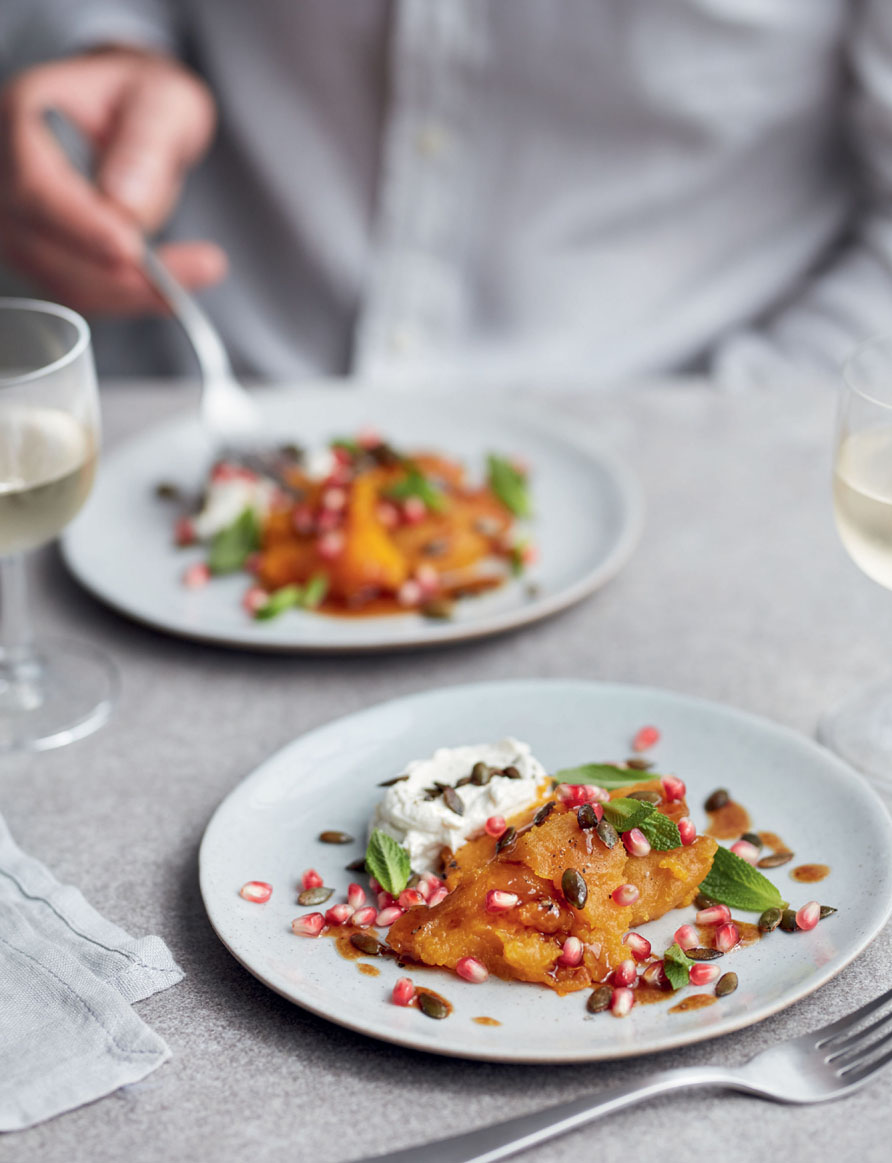
TEMPURA FENNEL WITH FENNEL MARMALADE AND GARLIC AIOLI
Tempura is always a treat but generally it is reserved for fish or seafood. This recipe uses fennel, which has a lovely flavour when it’s effectively ‘steamed’ in the light, crisp batter. In this recipe, there are also two other unusual elements – a fennel ‘marmalade’ whereby the fennel is caramelised and releases its own sugars to create a sweet condiment, and a vegan aioli made with chickpea water.
Serves: 4 as a starter
Preparation time: 25 minutes
Cooking time: around 1 hour
2 tbsp vegetable oil, plus extra for deep-frying
1 fennel bulb, finely sliced, plus 1 bunch baby fennel bulbs, each bulb halved lengthways
grated zest and juice of 1 lemon
sea salt and freshly ground black pepper
FOR THE AIOLI
60g aquafaba (the liquid from a 400g tin of chickpeas, strained through a sieve)
1 tbsp white wine vinegar
1 garlic clove, finely grated
½ tsp Dijon mustard
175ml olive oil
50ml vegetable oil
½ tsp table salt
FOR THE TEMPURA BATTER
6 tbsp cornflour
3 tbsp plain flour, plus extra for dusting
3–6 tbsp soda water
Heat the 2 tablespoons of vegetable oil in a medium saucepan over medium heat. When hot, add the finely sliced fennel. Season lightly with sea salt, reduce the heat and cook gently for 40–50 minutes, stirring regularly, until it caramelises and turns a dark golden brown. Add half the lemon zest and juice and cook for a further 2 minutes. Remove from the heat, transfer to a dish and leave to cool.
To make the aioli, put the aquafaba in a bowl and, using a balloon whisk, mix in the vinegar, garlic and Dijon mustard. Put both oils in a jug and slowly drizzle them into the aquafaba mixture, whisking continuously as you do so. When it reaches a thick mayonnaise consistency, season with table salt and the remaining lemon zest and juice.
To make the tempura batter, mix the flours together in a bowl with a pinch of sea salt and a pinch of pepper. Gradually whisk in enough of the soda water to make a thick batter.
Pour enough vegetable oil into a deep-fat fryer or large, deep saucepan to come up to 6cm and heat to 180°C.
Dust the baby fennel slices in the flour then, one by one, dip them in the tempura batter and carefully place them in the hot oil. Fry (in batches) for 4–6 minutes until golden and crisp. Remove with a slotted spoon and transfer to kitchen paper to remove any excess oil.
Serve the tempura immediately, with the marmalade and aioli.
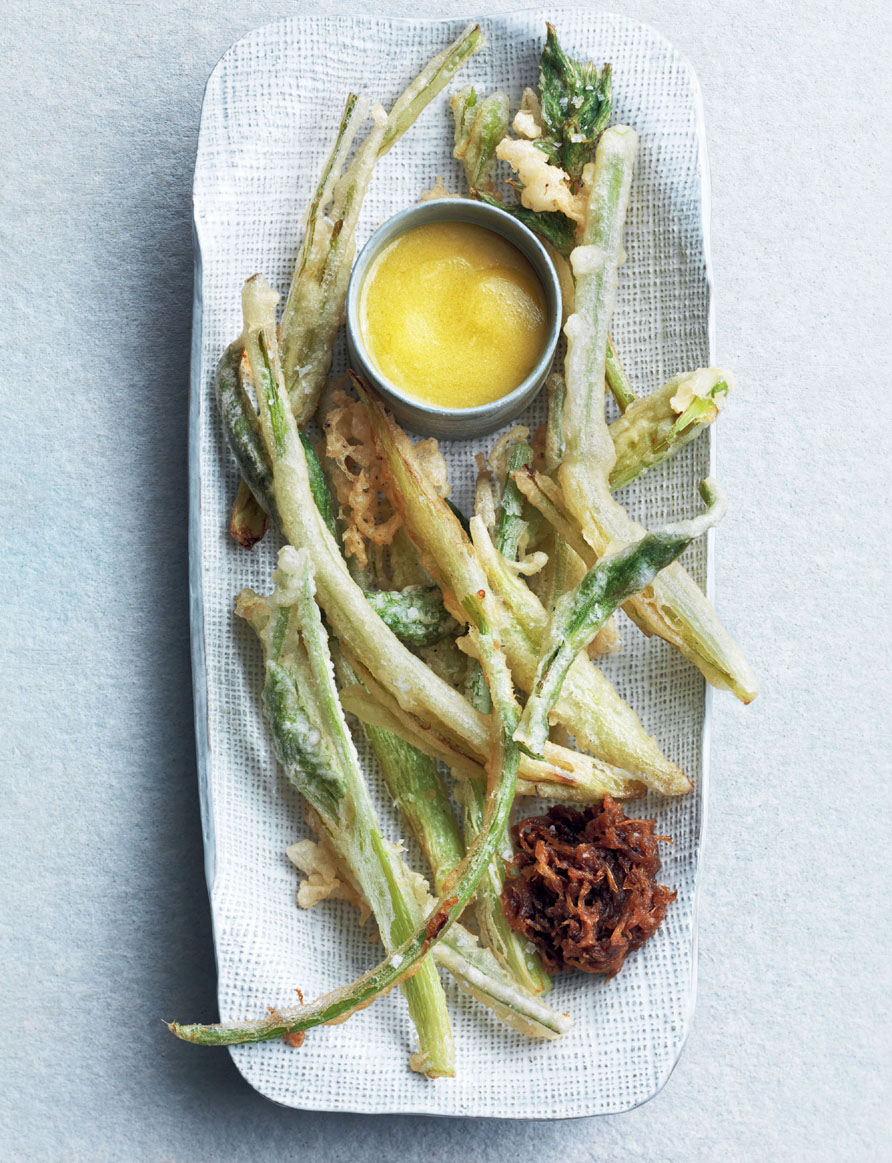
TAGLIATELLE WITH BUTTERNUT SQUASH, HAZELNUTS AND CRISPY SAGE
There are many versions of classic pasta dishes but this take on squash pasta is such a great comfort food. This is a relatively quick but very tasty dish which satisfies the whole family at my house. The savouriness of the sage adds an extra lift. You can use dried or fresh pasta.
Serves: 4
Preparation time: 15 minutes
Cooking time: 35 minutes
1 butternut squash, peeled, halved, deseeded and diced
2 bay leaves
4 sprigs of thyme
½ nutmeg, grated
75g butter
80g blanched hazelnuts, roughly chopped
20 sage leaves
350g tagliatelle pasta
sea salt and freshly ground black pepper
Put the diced squash in a medium saucepan, cover with cold water, season with a generous pinch of salt and add the bay leaves and thyme. Bring to the boil and simmer for 20–25 minutes until tender, then strain off the water and remove the bay leaves and thyme sprigs.
Add the nutmeg and 25g of the butter and lightly mash the squash. Season to taste and keep warm.
Heat the remaining 50g butter in a large frying pan over high heat. When foaming, add the hazelnuts and sage. Season with sea salt and pepper and cook for 5–8 minutes until golden and crispy, and the butter has browned.
Cook the tagliatelle according to the packet instructions. Drain and mix with most of the hazelnut and sage butter. Gently mix through the butternut squash mash and serve, topped with the remaining hazelnut, sage and brown butter.

COURGETTE, SPELT AND CUMIN FRITTERS
These fritters make a lovely summery meal – fresh, vibrant and full of nutrients. They are simple to make and if you choose a vegan cheese they can be vegan friendly, too. Try to use whole spices rather than ground, toasting them and crushing them when required; the flavour is much more intense. The cashew salad adds a lovely richness to the dish.
Serves: 4
Preparation time: 25 minutes, plus 30 minutes salting
Cooking time: about 50 minutes
5 green courgettes, 4 coarsely grated (around 1kg total grated weight)
2 tsp table salt
1 yellow courgette, sliced into ribbons
80g cashew nuts, roasted and roughly chopped
FOR THE FRITTERS
100g spelt
4 tbsp vegetable oil, plus extra for frying
4 shallots, finely diced
1 garlic clove, finely grated
2 tbsp cumin seeds, toasted and crushed
4 tbsp plain flour, plus extra for coating
grated zest of ½ lemon
3 tbsp finely chopped flat-leaf parsley
70g grated vegan cheese or Cheddar cheese
½ tsp English mustard powder
sea salt and freshly ground black pepper
FOR THE VINAIGRETTE
4 tbsp olive oil
1 tbsp white wine vinegar
½ tsp wholegrain mustard
Put the grated courgette in a colander, sprinkle with the 2 teaspoons of table salt and toss to distribute the salt. Set the colander over a bowl or the sink and leave for 30 minutes to drain.
Cook the spelt according to the packet instructions. Drain well. Heat 2 tablespoons of the vegetable oil in a frying pan over medium heat. When hot, add the shallots and garlic and cook for 5–7 minutes until soft but not browned. Add the cumin, mix well, then transfer to a bowl.
Put the grated courgettes in a clean tea towel and squeeze out as much of the liquid as possible. Tip them into the bowl with the shallots and garlic. Add the flour and lemon zest and mix well. Add 2 tablespoons of the chopped parsley, the cheese, cooked spelt, mustard powder and a generous twist of black pepper. Fry a little of the mix in a pan with a little oil, taste to check the seasoning and add more salt if necessary. Shape the mixture into 12 balls, then flatten into patties.
To make the vinaigrette, whisk the olive oil, white wine vinegar and wholegrain mustard together in a bowl. Set aside. Slice the remaining green courgette into circles then mix with the yellow ribbons, the remaining chopped parsley and the cashew nuts.
Heat the remaining 2 tablespoons of vegetable oil in a large, non-stick frying pan over medium heat. When hot, add half the patties and fry for about 5 minutes on each side, until golden on the outside and cooked through. Repeat with the remaining patties.
To serve, place two fritters on each plate, dress the courgette ribbons and rounds with the vinaigrette, season with sea salt and pepper and serve alongside the fritters.
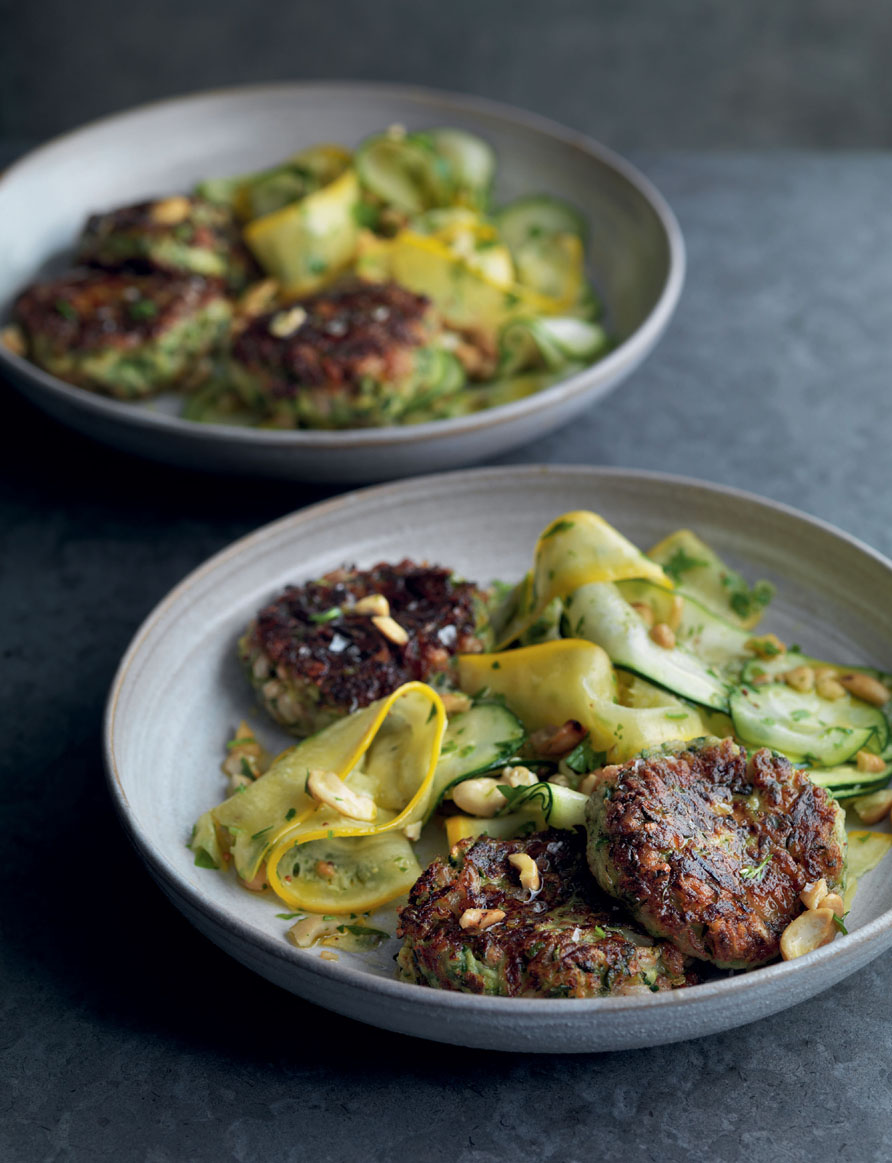
MUSHROOM ‘RAVIOLI’ WITH SHALLOT SAUCE AND GRILLED SPRING ONIONS
These ‘ravioli’ are made with dumpling wrappers rather than pasta. They are very handy to have in the freezer for when you want to make this modern version of ravioli. It’s the perfect way to practise your ravioli-making skills without having to make fresh pasta. This whole dish is also dairy-free and egg-free.
Serves: 4 (makes 12 ‘ravioli’)
Preparation time: 35 minutes, plus cooling
Cooking time: around 1 hour 10 minutes
24 gyoza wrappers
1 bunch of spring onions, roots trimmed off
1 tbsp olive oil
sea salt
FOR THE MUSHROOM FILLING
1 tbsp vegetable oil
1 shallot, finely diced
2 flat-cap mushrooms, finely diced (around 175g)
2 sprigs of thyme
1 bay leaf
15ml Madeira wine
FOR THE SHALLOT SAUCE
2 tbsp vegetable oil
4 shallots, finely sliced
4 tbsp balsamic vinegar
400ml coconut milk
To make the mushroom filling, heat the vegetable oil in a large saucepan over medium heat. Add the diced shallot and cook for 7–10 minutes, until soft but not brown. Increase the heat to medium-high, add the mushrooms, thyme, bay leaf and season well with sea salt. Cook for about 10 minutes until all of the liquid from the mushrooms has evaporated, then add the Madeira and cook until it has evaporated. Remove the thyme sprigs and bay leaf and place the mushroom mix in a container. Cover and chill.
To make the shallot sauce, heat the vegetable oil in a medium saucepan over medium-high heat. Add the sliced shallots, season with sea salt, and cook for 5–7 minutes, stirring regularly, until they are a deep golden colour. Add the balsamic vinegar and simmer until all the liquid has evaporated. Add the coconut milk and simmer for 5 minutes. Place in a blender and blitz until smooth, then pass through a fine sieve into a bowl to remove any lumps.
To make the ravioli, gently brush the outside edges of one of the gyoza wrappers with a little water. Place a scant tablespoon of the mushroom filling in the centre and place another gyoza wrapper on top. Press the edges to seal, making sure you remove any air trapped inside. Continue with the remaining wrappers and filling until you have 12 ravioli. Arrange them in a single layer in a steamer set over a pan of boiling water (you may need to steam them in batches, keeping the cooked dumplings hot while you cook the rest). Steam for 5–7 minutes.
For the spring onions, heat a griddle pan until smoking. Drizzle the trimmed onions with the olive oil, season and grill until just blackened.
Serve 3 ravioli per portion, with the shallot sauce and grilled spring onions.
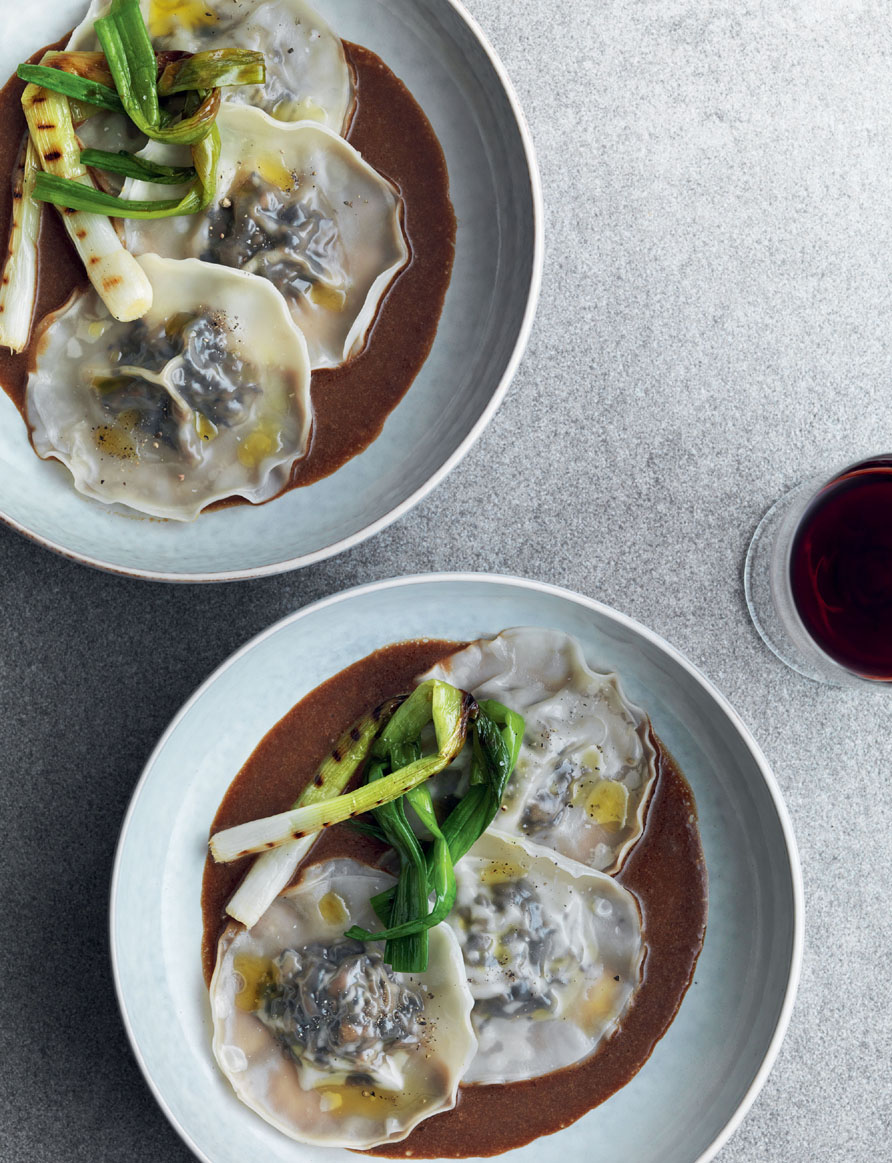
HERITAGE TOMATO, SESAME AND MISO TARTS
This is the perfect dish for an impressive but light summer lunch, when tomatoes are at their finest and the rosé is flowing. Filo pastry is a versatile product to always have in the fridge, given it can be used for sweet and savoury dishes and is rather quick to cook. It’s dairy-free and egg-free, too.
Makes: 4 tarts
Preparation time: 25 minutes
Cooking time: 20 minutes, plus cooling
6 sheets filo pastry
7 tbsp olive oil
1 tbsp black sesame seeds, plus extra to serve
4–8 Heritage tomatoes (depending on their size)
flat-leaf parsley, to serve
sea salt and freshly ground black pepper
FOR THE TOMATO SAUCE
75g semi-dried tomatoes
1 tsp tomato purée
4 tsp olive oil
1 tbsp chopped flat-leaf parsley
FOR THE TAHINI-MISO DRESSING
2 tbsp tahini
2 tbsp rice wine vinegar
1 tbsp white miso paste
2 tbsp olive oil
Preheat the oven to 200°C/180°C fan/gas 6.
Brush each layer of the filo with olive oil and layer one on top of the other. Brush the top with more oil (you’ll use about 5 tablespoons oil in total) and sprinkle it with the sesame seeds. Trim the edges then cut the layered filo stack into eight 8 × 12cm rectangles. Place them between two sheets of baking parchment then put on a baking sheet, with another baking sheet on top to keep the filo flat. Bake for 6–8 minutes, then remove the top baking sheet and the top sheet of baking parchment and bake for a further 8–10 minutes, until golden. Remove from the oven and leave to cool on a wire rack to crisp up.
To make the tomato sauce, blitz the semi-dried tomatoes in a blender or food processor with the tomato purée, olive oil and parsley. Taste and adjust seasoning if necessary.
To make the tahini-miso dressing, whisk the tahini, rice wine vinegar, miso paste and olive oil together in a bowl. Add a few tablespoons of water if it is too thick – it needs to be drizzling consistency.
Slice the tomatoes and drizzle them with the remaining 2 tablespoons of olive oil. Season with sea salt and pepper.
To assemble the tarts, divide the semi-dried tomato mix evenly between the eight filo rectangles, spreading out evenly over the pastry. Top with the sliced tomatoes then drizzle with the tahini-miso dressing. Place one rectangle on top of another and garnish with black sesame seeds and parsley.
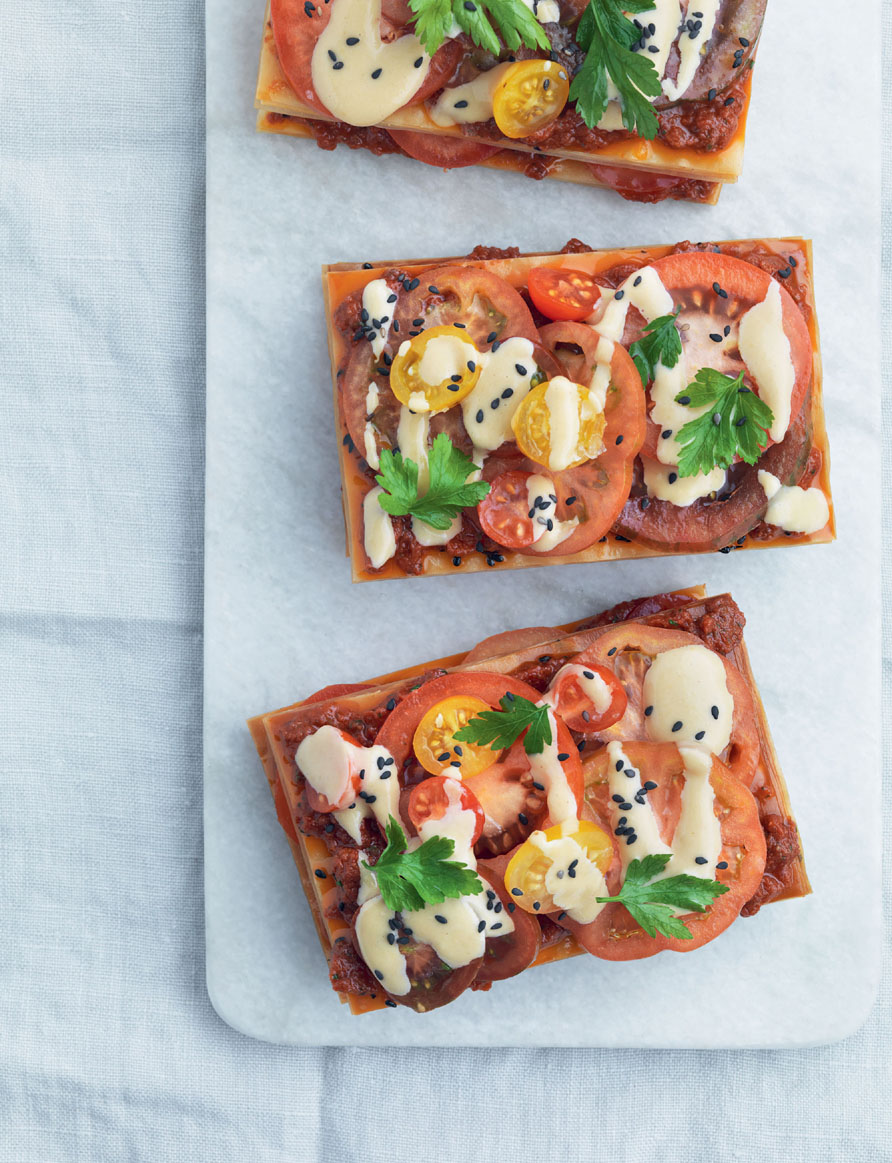
SPINACH, RICOTTA AND BASIL PESTO CANNELLONI
Baked cannelloni is a great dish to make in advance, as it gets better when left in the fridge for a day or two. So it’s perfect for a make-ahead family meal on a weeknight, or a treat at the weekend. The trick to making cannelloni is to ensure there is enough liquid during cooking for the dried pasta to absorb, as well as to coat the pasta tubes for serving. Cottage cheese works as a great substitute for ricotta, too, and can add a little more texture to the overall dish.
Serves: 4–6
Preparation time: around 1 hour
Cooking time: 1 hour 30 minutes
500g baby spinach leaves
500g ricotta cheese, drained
200g grated Cheddar cheese
½ nutmeg, finely grated
250g dried cannelloni tubes
100g grated Gruyère cheese
sea salt and freshly ground black pepper
FOR THE TOMATO SAUCE
1 tbsp vegetable oil
1 onion, sliced
1 garlic clove, crushed
400g tomato passata or 1 × 400g tin chopped tomatoes
1 tbsp tomato purée
2 tbsp balsamic vinegar
2 tbsp Worcestershire sauce
50ml Vegetable Stock
FOR THE WHITE SAUCE
600ml milk
1 small onion, peeled but left whole
10 cloves
1 bay leaf
50g butter
50g plain flour
FOR THE BASIL PESTO
40g pine nuts
1 bunch of basil, leaves only
30g grated Parmesan cheese
2 garlic cloves, crushed
100ml olive oil
Preheat the oven to 200°C/180°C fan/gas 6.
To make the tomato sauce, heat the oil in a saucepan over medium heat and add the onion and garlic. Cook for 10 minutes until soft and golden, stirring frequently. Add the remaining sauce ingredients, season with sea salt and pepper and bring to a simmer. Cook over medium heat for 30 minutes, stirring occasionally. Transfer to a blender or use a stick blender to blitz the sauce to a smooth consistency, then leave to cool.
While the tomato sauce is cooking, make the white sauce. Put the milk in a small saucepan, stud the onion with the cloves and add it to the milk along with the bay leaf. Gently bring to the boil over low heat. Remove from the heat and leave to infuse for a few minutes before removing the bay leaf and onion.
Melt the butter in a saucepan over low heat and add the flour and a pinch each of sea salt and pepper. Cook for about 1 minute to get rid of the floury taste, but avoid letting it brown. Add a ladle of the warm milk and stir to combine. Continue adding the milk, a little at a time, until it’s all incorporated. Bring to the boil then simmer gently for a few minutes, until you have a thick pouring sauce. Keep warm, over very low heat or off the heat covered with a lid, while you prepare the rest of the ingredients for the cannelloni.
Bring a large pan of salted water to the boil and blanch the spinach for l minute. Refresh under cold running water and drain well. Squeeze out the excess moisture from the leaves and roughly chop.
Mix the ricotta with the Cheddar cheese and grated nutmeg in a bowl and season to taste with sea salt and pepper. Add the spinach and mix well.
To make the basil pesto, put the pine nuts on a baking tray and toast them in the oven for 6 minutes, shaking the tray halfway through. Remove from the oven and leave to cool, and reduce the oven temperature to 190°C/170°C fan/gas 5. Put the basil, Parmesan, garlic, oil and toasted pine nuts in a blender and blitz to form a chunky pesto. Season well.
Put the ricotta and spinach mix in a piping bag and pipe it into the cannelloni tubes. Lay the filled cannelloni tubes in one layer in a large lasagne dish and cover with a layer of tomato sauce and basil pesto. Cover the cannelloni with the cheese sauce, scatter over the grated Gruyère and season with sea salt and pepper.
Bake for 45–50 minutes until the sauce is bubbling and the pasta is al dente.
KABOCHA SQUASH, PARMESAN AND ROSEMARY TART
Kabocha squash are the ideal variety of squash for this recipe as they have a low moisture content so the pastry will remain deliciously crisp. The pairing with Parmesan and rosemary complements the sweetness of the squash perfectly. I love to make this at the end of summer and serve it with a green salad for a tasty weekend lunch.
Serves: 6
Preparation time: 20 minutes
Cooking time: about 1 hour
1 kabocha or butternut squash, peeled, halved and deseeded
2 tbsp vegetable oil
1 × 320g sheet of ready-rolled all-butter puff pastry
1 tbsp finely chopped rosemary
30g pine nuts
60g grated Parmesan cheese
1 garlic clove, finely grated
50ml olive oil
3 tbsp mascarpone
sea salt and freshly ground black pepper
Preheat the oven to 210°C/190°C fan/gas 7 and line a baking tray with baking parchment.
Slice each squash half into 1cm-thick slices and place them in a single layer on a roasting tray. Drizzle with the oil and season liberally with salt and pepper. Bake for 15–20 minutes until just tender.
Lay the pastry out flat on the lined baking tray and carefully score a 1cm border around the edge.
Place the rosemary, pine nuts, half the Parmesan, the garlic, olive oil and a pinch of sea salt in a tall container and blend using a stick blender. Add the mascarpone and pulse until combined.
Spread the mix inside the border on the puff pastry. Lay the squash slices over the mix and finish with a good dose of black pepper.
Bake for 30–35 minutes until golden. Sprinkle over the remaining Parmesan and place back in the oven until the cheese melts. Serve hot.
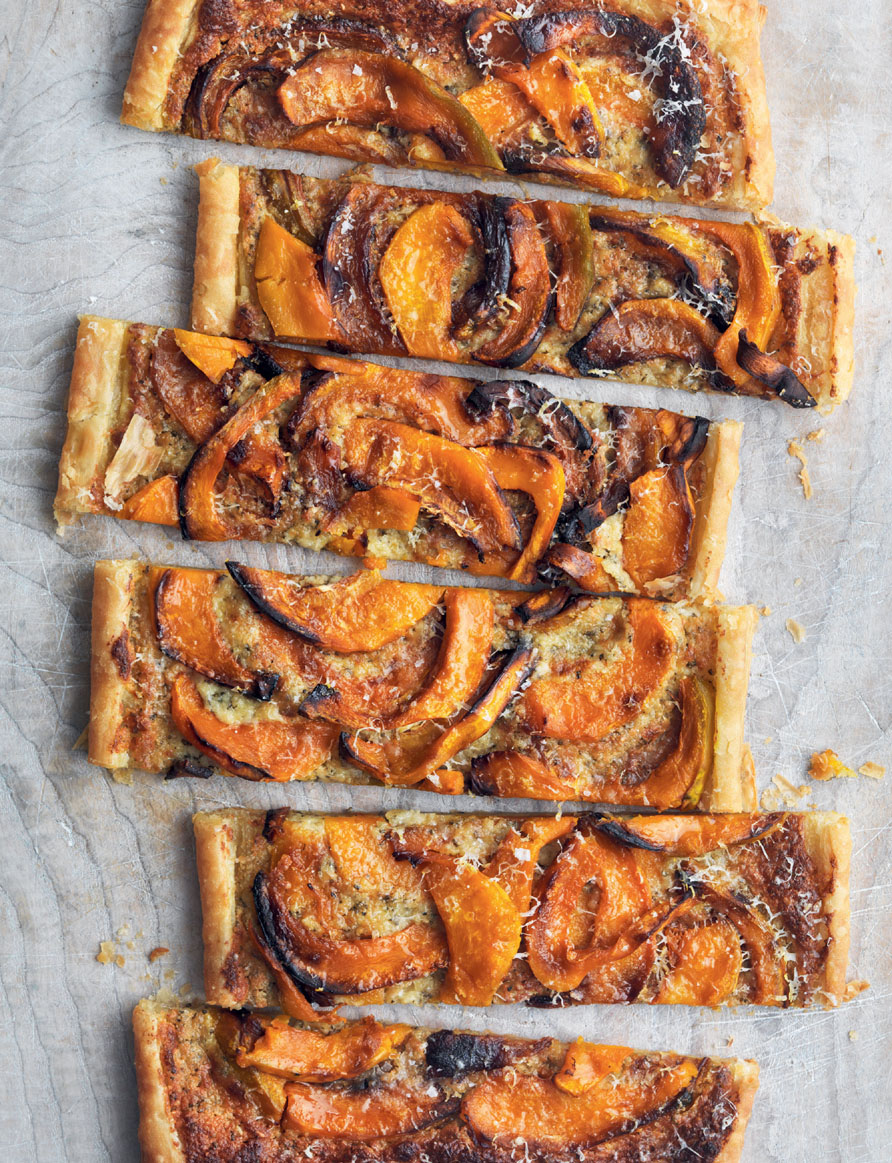
BRAISED TOFU WITH BUCKWHEAT, CAVALO NERO AND CAPERS
Tofu itself is a rather flavourless ingredient, however it does add a good texture to dishes. If you have never been a fan then do try this dish as the flavours work really well together and create a tasty and wholesome meal. Always use firm tofu, and preferably a refrigerated product, not an ambient, shelf-stocked one, as the flavour and texture are much better.
Serves: 4
Preparation time: 15 minutes
Cooking time: about 50 minutes
2 tbsp vegetable oil
2 onions, thinly sliced
200g buckwheat
2 tbsp olive oil
2 garlic cloves, finely grated
½ red chilli, deseeded and finely diced
2 tbsp balsamic vinegar
1 tbsp picked thyme leaves
2 tbsp tomato purée
2 tbsp Worcestershire sauce
300ml Vegetable Stock
350g firm tofu, cut into 5mm dice
200g cavolo nero or kale, tough stems removed and leaves roughly sliced
3 tbsp capers in brine, strained and finely chopped
sea salt and freshly ground black pepper
Heat the vegetable oil in a deep frying pan over high heat. When hot, add the onions, season with sea salt and pepper and cook for 15–20 minutes until golden and caramelised.
Meanwhile, toast the buckwheat in a dry frying pan for 5 minutes over medium heat, then cook it according to the packet instructions. Drain well and stir through the olive oil. Keep warm.
Add the garlic and chilli to the onions and cook for a further 4 minutes, until soft, then add the balsamic vinegar and cook until it coats the onion mix. Add the thyme, tomato purée, Worcestershire sauce and 200ml of the vegetable stock and mix well. Simmer rapidly for 5 minutes.
Scatter the tofu in the frying pan on top of the onion mixture. Reduce the heat to low and cook the tofu for 10 minutes.
Add the cavolo nero to the pan with the capers. Add the remaining vegetable stock. Cover the frying pan and cook gently for about 5 minutes, or until the cavolo nero is cooked. Stir to combine.
Spoon the buckwheat into bowls then top it with the braised tofu, cavolo nero and caper sauce.
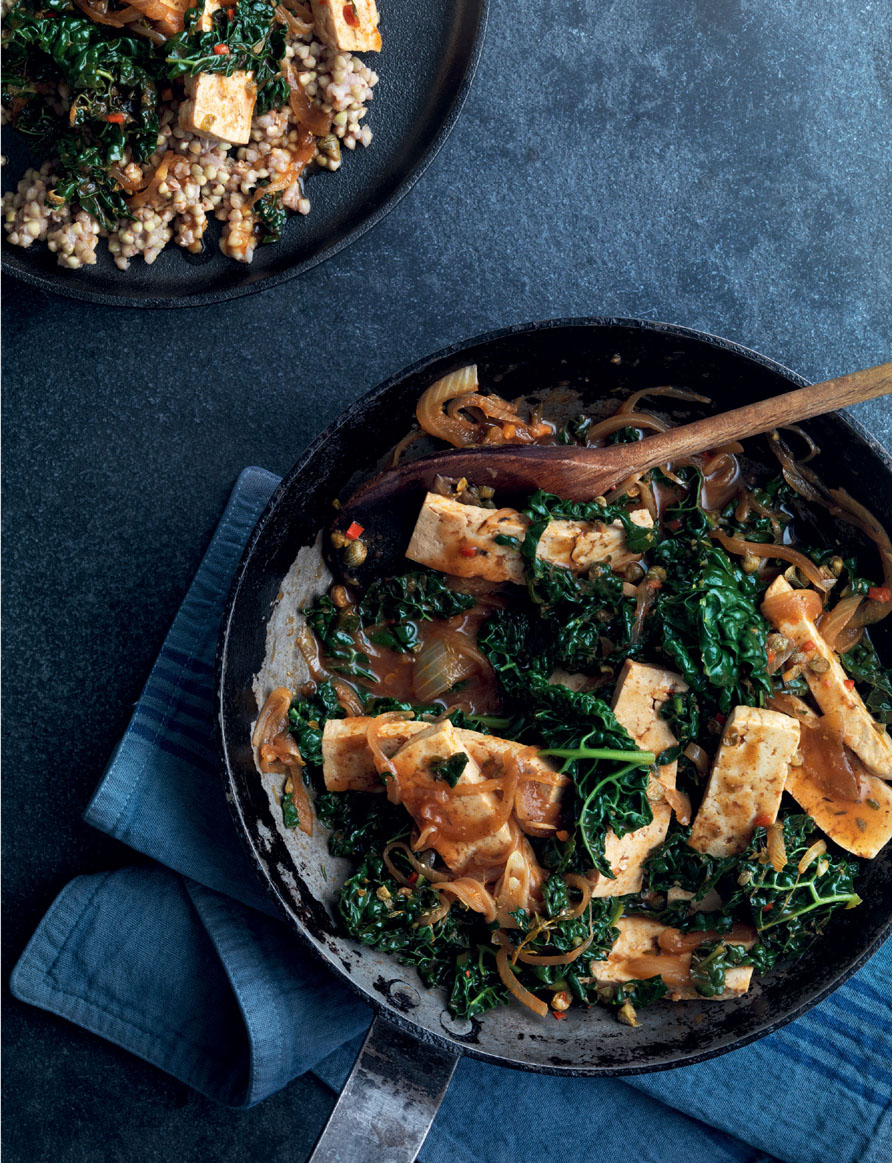
CAULIFLOWER BHAJIS WITH MANGO AND CORIANDER YOGHURT
A bhaji is an Indian fritter, typically made with onions and loads of spices. I have used cauliflower along with the onion, as it gives the bhajis a slight nuttiness. The sweet, slightly spiced yoghurt is a great accompaniment, too.
Serves: 4 as a starter (makes about 16 bhajis)
Preparation time: 25 minutes
Cooking time: around 50 minutes
25g butter
2 onions, finely sliced
1 cauliflower, grated (a box grater works well)
1 green chilli, deseeded and finely diced
3 tbsp chopped coriander
1 egg
125g chickpea flour
½ tsp baking powder
vegetable oil, for deep-frying
sea salt and freshly ground black pepper
FOR THE SPICE MIX
1 tsp ground turmeric
1 tsp cumin seeds
¼ tsp coriander seeds
¼ tsp black mustard seeds
½ tsp garam masala
FOR THE MANGO AND CORIANDER YOGHURT
2 tbsp mango chutney
1 tbsp finely chopped coriander
½ tsp nigella seeds
1 tsp sriracha sauce (hot chilli sauce)
100g Greek yoghurt
Melt the butter in a medium frying pan over medium-high heat. When hot, add the onions, season with sea salt and cook for about 5 minutes, then reduce the heat to medium and cook for a further 30 minutes, stirring frequently, until the onions are golden and caramelised. Add the grated cauliflower and cook for a further 4 minutes.
To make the spice mix, toast the ingredients in a small dry frying pan over medium heat until fragrant and the mustard seeds begin to pop. Remove from the heat and grind to a powder in a spice grinder or pestle and mortar.
Place the onion and cauliflower mix into a large bowl. Add the spice mix and mix well. Mix in the chilli, coriander and egg. Add the chickpea flour and baking powder and fold gently to just combine. Season with a pinch of salt and pepper.
To make the mango and coriander yoghurt, whisk all of the ingredients together in a bowl and season to taste.
Pour enough vegetable oil into a deep-fat fryer or large, deep saucepan to come up to 6cm and heat it to 160°C. Carefully place spoonfuls of the bhaji mix in the hot oil and fry in batches for 3–4 minutes until deep golden and crisp. Remove with a slotted spoon and transfer to kitchen paper, to soak up any excess oil. Season with sea salt and serve with the yoghurt.




